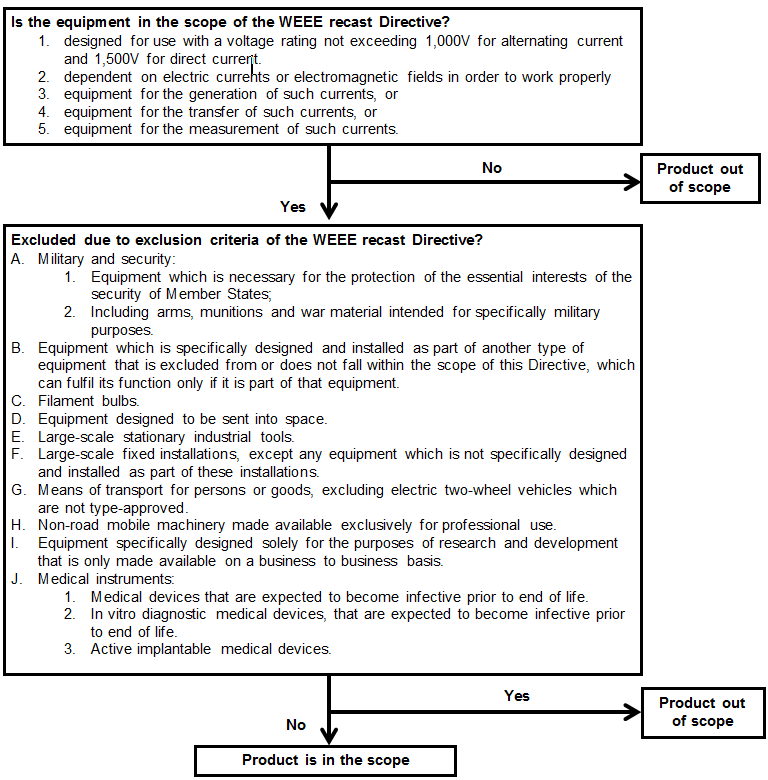Quick guide to Waste and Electronic Equipment Regulations – WEEE
Written by Tim Greenhalgh
Posted on January 7, 2015
The Waste Electrical and Electronic Equipment (WEEE) Regulations 2013 are a complex set of legal rules around relevant products being sold in the UK.
They cover all the identified Electrical and Electronic Equipment (EEE) placed on the market and can affect manufacturers, distributors and in some cases, business end users.
Companies might be obligated under WEEE Regulations and legally required to register with the Environment Agency, comply with the rules and so avoid fines from compliance breaches. They will need to keep full records for four years and report regularly.
Companies that fall under the regulations and fail to register may also be prevented from putting their EEE goods in the market as a registration number can be required.
Qualifying retailers are tasked to take back EEE products for recycling or join the Distributor Take Back Scheme (DTS).
Under WEEE Regulations, companies are defined as an EEE producer if they put equipment on the UK market by:
- Manufacturing or rebranding/reselling EEE products
- Importing/exporting EEE into the UK or another EU country on a professional basis
These regulations apply to EEE producers regardless of size. The costs involved depend on weight and types of products being manufactured and sold.
Companies defined as EEE producers must:
- mark products with the crossed out wheeled bin symbol and a date mark
- provide information on reuse and environmentally sound treatment of the products and components (includes materials, dangerous substances and preparations) within one year of putting them on the market
- make sure that distributors have the producer registration number
- keep records for at least four years of the amount of EEE put on the market by category.
EEE waste producers have to register as a producer or join a producer compliance scheme (PCS). Companies that place less than five tonnes of EEE on the UK market in a compliance year can register direct with the environmental regulator as a “small producer”.
Distributors who may fall under the WEEE Regulations include
- retail outlets
- wholesale outlets
- mail order
- the internet
- TV shopping channels
- other distance-selling methods
Companies that sell EEE products to domestic customers are required to take back waste products on a like for like basis when selling a new product, like a fridge.
This requirement does not apply to products sold to business customers but distributors can be asked to help business customers and suppliers to meet their obligations.
These waste management regulations apply to products sold after August 13th 2005.
Businesses that are the final user of any EEE sold before August 13th 2005 and which is not being replaced on a like for like basis are required to cover costs of collection, treatment and recycling.
The main question that companies need to ask is: Does the item of EEE fall into one of the 14 categories listed in Schedule 1 of the Regulations? These reporting categories are:
- Category 1 – large household appliances such as fridges, radiators and air conditioning appliances
- Category 2 – small household appliances such as sewing machines, toasters and clocks
- Category 3 – IT and telecommunications equipment such as computers and their accessories, calculators and phones
- Category 4 – consumer equipment such as TVs, radios and musical instruments
- Category 5 – lighting equipment such as fluorescent lamps and non-household luminaires
- Category 6 – electrical and electronic tools such as drills, welding equipment and lawnmowers
- Category 7 – toys, leisure and sports equipment such as electric train sets, video games and slot machines
- Category 8 – medical devices such as dialysis machines, ventilators and radiotherapy equipment
- Category 9 – monitoring and control instruments such as smoke detectors, thermostats and other instruments used in industrial installations
- Category 10 – automatic dispensers such as drinks, food and money dispensers
- Category 11 – display equipment
- Category 12 – appliances containing refrigerants
- Category 13 – gas discharge lamps and LED light sources
- Category 14 – photovoltaic panels
As an example of the detail, Category 5 (lighting) includes straight fluorescent lamps, compact fluorescent lamps, high intensity discharge lamps, including pressure sodium lamps and metal halide lamps, low pressure sodium lamps, luminaries for fluorescent lamps with the exception of luminaries in households, other lighting or equipment for the purpose of spreading or controlling light with exception of filament bulbs.
The regulations cover only products that depend on electric currents or electromagnetic fields for basic function, so a domestic gas cooker would normally not be “in scope”. Government guidance also advises that articles such as talking dolls and musical greetings cards are not EEE.
The best advice on WEEE Regulations is, if you are in doubt as to your compliance status, seek professional advice and/or master the lengthy documentation provided by the government.
Further information:
The Waste Electrical and Electronic Equipment Regulations 2013
Electrical and electronic equipment (EEE): producer responsibility
